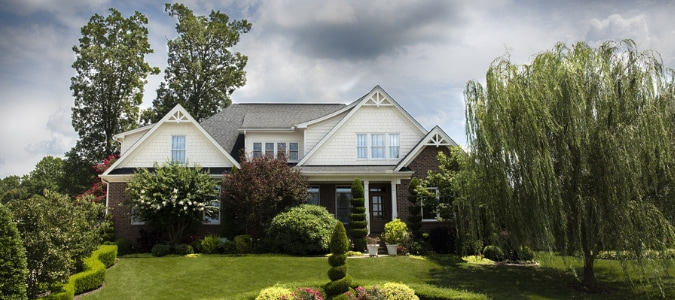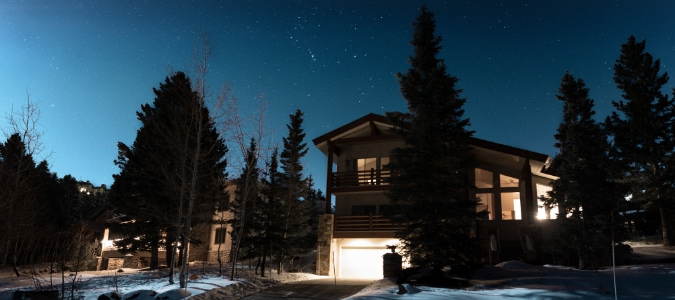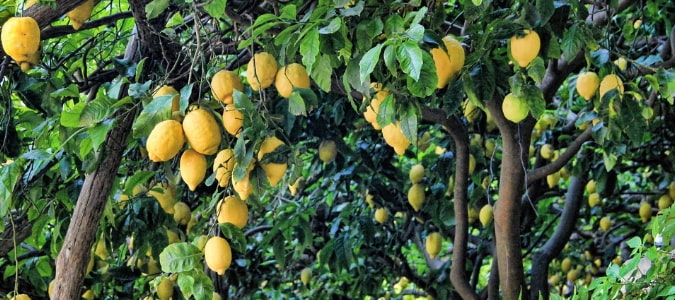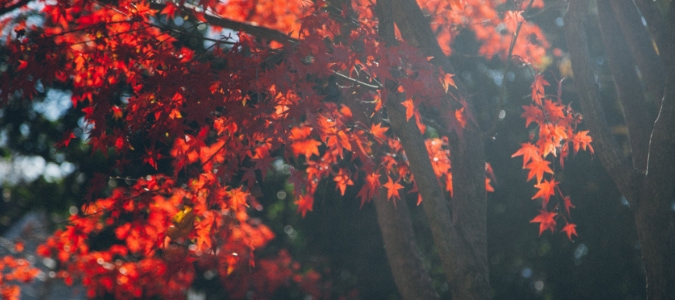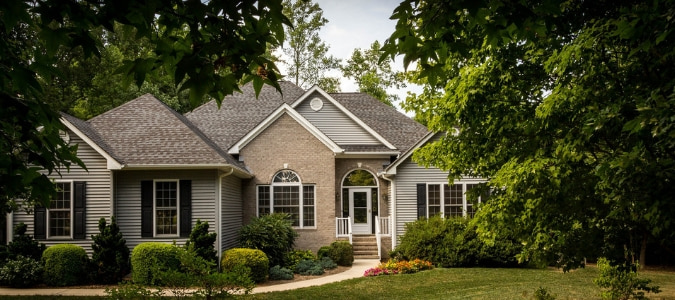
When you moved into your home, you realized that you had a lot of room to grow—quite literally—in the tree department. You probably expected that over time, your trees would provide you with much-needed shade on a hot summer day, a reduction in your utility bills and an improvement to your curb appeal.
So, what if that wasn’t the case? What if you now want to make up lost time so that you can enjoy the benefits of having trees on your property?
Below, we will explore which fast-growing trees tend to grow the best in southern states—USDA Zones 6-10—and divide them up by type. We’ll also provide you with important information about what conditions create optimal growth so that you can add these valuable plants to your landscape.
Fast-Growing Trees For Privacy
One of the biggest reasons people graduate from apartments to houses is to get more privacy. While a fence is nice, most of the time they leave a lot of the yard visible. No one wants to head out to the backyard if they feel like neighbors can watch their every move.
That’s where trees come in. With the right kind of trees, you can essentially put up a living wall between yards, if you so wish.
The tree species identified here both offer fantastic privacy and fast growth, making them optimal for dealing with prying eyes both quickly and effectively.
Leyland Cypress
These trees grow very well in Zones 6-10, making them perfect for pretty much anywhere in the American south.
Leyland Cypresses grow incredibly quickly: about three to five feet per year. At maturity, these trees can be anywhere from 40-60 feet high and 20-25 feet wide.
If you want a privacy hedge, plant this variety of cypress about eight feet apart. If you’re looking for something that looks less like a solid wall, you can spread them out more.
Make sure these plants are in an area that gets plenty of sunlight and can put down roots in well-drained, rich soil. The optimal pH is between five and eight. Plant in mid-fall, if possible, when the trees are dormant.
If you prefer to create a pruned Leyland Cypress hedge, allow the trees to grow about a foot higher than you want the hedge to be. Top them about six inches below that height, then prune every summer to maintain that height.
Wax Myrtle
Rated for Zones 7-11, the Wax Myrtle range covers most of the southern U.S. This tree tolerates both droughts and heat and can even grow in infertile soil (as well as both moist and dry soil).
The Wax Myrtle grows as much as 5 feet per year. The maximum size this variety tends to get is about 20 feet tall.
While they are incredibly low-maintenance, Wax Myrtles benefit greatly from proper fertilization and watering and should be planted about 10 feet apart.
Yaupon Holly
A tough North American native, Yaupon Holly trees do well in Zones 7 through 9, thriving along both coasts, as well as across the southern states. This tree is routinely used for topiaries, screens and barriers. You can even see this tree in urban areas, parking lots and medians.
When this type of evergreen reaches maturity, it will grow to be somewhere between 15 and 25 feet tall and about the same width. Yaupon hollies take about ten years to reach this size.
To start this plant off right, choose a spot that will receive either part or full sun. If you want a tree which produces berries, choose a female plant. You won’t need to plant this tree any differently than other trees, but you will need to prune sprouts twice or three times each year to keep the base looking tidy.
Fast-Growing Evergreen Trees
Notice anything about the privacy trees above? Many of them are evergreens!
Because of that, we’ll keep this section short, but just know that there are plenty of evergreens to choose from, including the varieties we’ve already discussed.
Japanese Cedar
The national tree of Japan, this roughly pyramid-shaped evergreen can be grown from Zones 5-9.
You can expect robust growth of around 3-4 feet each year if you choose to add a Japanese Cedar to your landscape.
Depending on the variety, you want to plant this tree in an area with sun to partial shade, or stronger shade. Water quite a bit at planting and over the first week. Then make sure to soak it every week over the summer, unless you’re getting more than an inch of rain. Depending on your desired size and look, you can space them anywhere from 5-20 feet apart.
Thuja Green Giant
Hardy from Zones 5-9, the Green Giant resists insects and droughts and can be planted in all soil types.
You can expect this type of tree to grow around three feet per year.
You’ll want to break the soil up about 12 inches deep when planting to give the Giant’s root ball room to branch out. If you want a privacy fence, use a rototiller to break up a section of soil about 12 inches deep and three feet wide, and base your length on the number of trees you’re planting. You’ll want to space the trees about 6 feet apart.
Thujas need lots of water in the beginning. In warm weather, water every day for the first two weeks. You can then switch to every other day in cooler weather, then cut back to once a week for the remainder of the first year.
Fast-Growing Fruit Trees
Fruit trees can be wonderful in your yard for a variety of reasons—not the least of which is the fact that you’ll get some delicious fruit every year!
Black Cherry
A black cherry tree will do well anywhere from Zone 3 to Zone 9.
These fruit trees grow about three feet per year.
These trees tend to like the sun, but they can handle some shade as well. Keep them well away from any walkways, though, because when their fruits drop, they tend to stain.
Plant these trees about 8 to12 feet apart in rich soil and add a layer of mulch about six inches from the trunk. As they grow, keep checking to make sure the soil stays on the acidic side.
Avocado
Haas and Fuerte avocado trees grow best in Zones 9 and 10, which make them perfect for southern Texas and Florida.
You can expect avocado trees to grow around three feet a year.
We’ll focus on Haas trees, since they are popular. Find a location with full sun that is sheltered from the wind and has well-drained soil. These trees are best planted between March and June.
Water immediately and frequently, around two to three times a week with two to five gallons at each watering for most of the first year. You’ll also want to add gypsum around the tree, as well as mulch and fertilizer.
Meyer Lemon Tree
These lemon trees grow well in Zones 8-11.
In the early years, Meyer lemon trees grow as much as four feet per year. Graft a tree and you can have lemons in as little as two years. Grow from a seed, and your plant will reach maturity in four to seven years.
While Meyer lemon trees need at least six hours of sunlight, the best location will be one that lets in morning sun but offers some shade in the afternoon. Use moist, but well-draining soil, and add high nitrogen or specialty citrus fertilizer monthly, except in the fall and winter.
Fast-Growing Shade Trees For Small Yards
If there’s one thing southern yards need, it’s protection from the scorching summertime sun. Shade trees in Texas and other southern states can turn your yard from a no-go zone into a lush paradise for the family—all while lowering your electric bill.
Red Maple
Southern homeowners will be happy to learn that the red maple thrives in every part of the south, except for the southernmost tip of Florida. Listed as appropriate for Zones 4-9.
These trees grow pretty fast. How fast, exactly? You can expect growth of around three to five feet per year, topping out at around 40 feet.
The red maple is fairly hardy and adaptable. This variety typically grows well in light conditions that vary from full sun to partial shade and soil that ranges from sand to clay (so long as it’s well drained).
The biggest drawback for some southern homeowners is that it only has a moderate drought resistance, which can be problematic.
Lemon Bottlebrush
This gorgeous tree, which attracts hummingbirds, is best suited for Zones 9 and 10.
Compared to many other trees on this list, the Lemon Bottlebrush doesn’t grow that fast. You can expect it to grow anywhere from 10-15 inches per year. So, why include it? Because it’s on the smaller side (topping out around 25 feet) and tolerant of both drought and heat, making it ideal for many southern yards. Plus, the red flowers it bears are gorgeous. And, you know, hummingbirds.
Here’s what you need to add this tree to your yard: a sunny, well-drained location. Beyond that, Lemon Bottlebrush doesn’t really care. Even watering is comparatively minimal. Once a week when they’re young and if there’s no rain, then you can taper off. Mulch over the root zone can help as well, but it’s not necessary. You shouldn’t even worry about fertilizing until the second season.
Southern Catalpa
This tree is rated for Zones 5-9, and is well-known as an “old-fashioned” shade tree in much of the southeast.
This variety grows slightly faster than Lemon Bottlebrush at 12-15” per year—so not super-fast. This plant also produces white flowers that smell when crushed, as well as bean pods that will fall seasonally.
If you’re looking for a good southern shade tree, the Catalpa has thick, dense foliage, and its flowers are gorgeous and fragrant in the spring. Catalpas are also very low maintenance (beyond the cleanup required for fallen flowers and seedpods).
To get this tree well-established, find a spot with full sunlight or partial shade, make sure the soil has strong drainage (ideally with a pH between 5.5 and 6) and water only when the surface of the soil is dry. At maturity, you can water even less.
ABC Can Add Fast-Growing Trees To Your Landscape
There are countless factors that go into choosing the right trees for your property. What are your goals? How fast do you want the growth to be? How much space do you have? How much sun? What kind of soil? While you can certainly do your own research and plant trees on your own, that’s a lot to take on if you’ve never done it before. Worse, it’s an expensive mistake if things don’t go as planned. If you want to add Texas native trees or want to make sure you get the right trees the first time—and provide them with the best chance to grow quickly—why not turn to the experts? The tree experts at ABC Home & Commercial Services know what it takes to get the best growth under different types of conditions. We can do the heavy lifting so that your yard can get the facelift you want.
